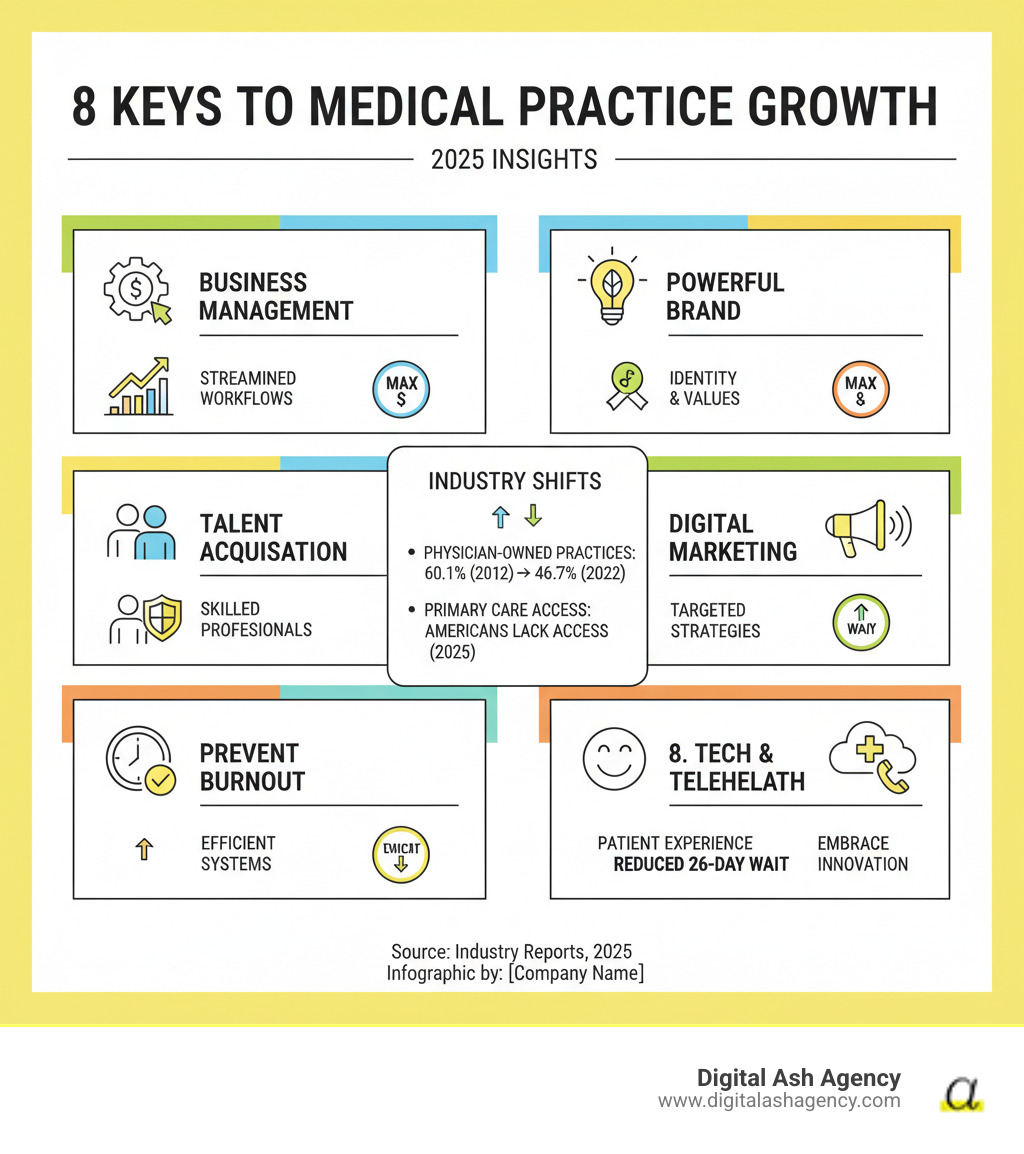
The Current State of Medical Practice Growth in America
How to grow a medical practice is a critical question for providers facing unprecedented challenges. As physician-owned practices declined from 60.1% in 2012 to 46.7% in 2022, independent practitioners must be strategic to thrive in a competitive landscape.
Quick Answer: The 8 Keys to Medical Practice Growth
- Master business management and create streamlined operational workflows
- Optimize your revenue cycle to maximize collections and reduce overhead costs
- Hire and retain skilled professionals who align with your practice values
- Prevent physician and staff burnout through efficient systems and work-life balance
- Develop a powerful brand identity that differentiates your practice
- Implement targeted digital marketing including local SEO and social media
- Improve the patient experience with reduced wait times and better communication
- Accept technology and telehealth to improve efficiency and expand services
The opportunity for growth has never been greater. More than 100 million Americans lack routine access to a primary care physician, a number that has nearly doubled since 2014. Meanwhile, the average wait time for new patient appointments has reached 26 days, creating clear demand for accessible, well-managed practices.
However, growing a medical practice requires more than clinical skills; it demands a comprehensive approach combining business acumen, strategic marketing, operational efficiency, and exceptional patient care.
I'm Ashley Gay, a branding expert specializing in how to grow a medical practice, especially for physicians in competitive markets. My husband's independent practice generated $239K in its first 90 days and nearly $1 million in its first year using the principles I'll share in this guide.

Learn more about how to grow a medical practice:
Keys 1 & 2: Fortify Your Business Strategy and Financial Health
Think of your practice like a patient: you must run comprehensive tests, review its history, and create a treatment plan. How to grow a medical practice starts with rock-solid business fundamentals. Without a healthy financial foundation and clear operational strategy, even the most skilled physicians can struggle.

Master Business Management and Operational Workflows
Before charting a course for growth, you need to know where you stand. A SWOT analysis is your diagnostic tool to honestly evaluate your practice's strengths, weaknesses, opportunities, and threats. This assessment provides the foundation for smart decision-making.
Once you understand your position, create a comprehensive business plan to serve as your roadmap. This living document outlines your vision, financial projections, and specific growth strategies.
Then, focus on streamlining workflows and improving operational systems. Analyze the patient's journey to identify bottlenecks at scheduling, check-in, or in staff processes. Every inefficiency costs time, money, and patient satisfaction. Smoothing out these rough edges allows your practice to handle more patients without chaos. The AMA STEPS Forward® Private Practice Playbook offers practical resources for these improvements.
For deeper insights, explore our guide on healthcare business growth strategies.
Effectively Manage Your Revenue Cycle
Excellent care doesn't guarantee healthy cash flow. If insurance claims are denied or forgotten, your practice's growth will stall. This is why revenue cycle management is critical.
Your revenue cycle begins when a patient schedules and ends when the final payment is received. Streamlining your claim submission process means getting claims out quickly and accurately the first time to avoid the denial-resubmission cycle.
Proactively monitor payer decisions to track claim statuses and understand why claims are denied. This knowledge helps prevent future issues. The goal is reducing claim denials by addressing common culprits like coding errors or missing patient information upfront.
Billing accuracy and efficient accounts receivable management are also key. Clean initial billing leads to faster payments, and organized systems make following up on outstanding balances smooth and professional. A well-oiled revenue cycle provides predictable cash flow, freeing your team to focus on patient care.
For support in optimizing these processes, see our solutions for healthcare practices.
Track Key Financial Metrics for Profitability
Your practice's financial metrics tell a story. Understanding how to grow a medical practice means becoming fluent in key performance indicators (KPIs)—the vital signs of your business health.
- Patient volume shows if your marketing and satisfaction efforts are working.
- Revenue per visit helps you understand the financial value of each encounter. A decline may signal a need to evaluate your fee schedule or improve coding.
- Net collections rate reveals how efficiently you convert care into payments. A low rate suggests problems in your revenue cycle.
- Overhead as a percentage of revenue tracks operational costs to ensure growth is profitable.
Monitoring these metrics consistently allows you to spot problems early and capitalize on opportunities, ensuring your growth is both sustainable and profitable.
For guidance on setting up these systems, visit our guide on starting a private practice.
Keys 3 & 4: Cultivate a Resilient and High-Performing Team
Behind every thriving medical practice is a dedicated team. Your staff members are the heartbeat of your practice—the first voice a patient hears and the reassuring presence in the exam room. Growth isn't just about attracting more patients; it's about building a team capable of delivering exceptional care consistently.

Prioritize Hiring and Retaining Skilled Professionals
The United States faces a projected shortage of up to 124,000 physicians by 2034, making every hiring decision crucial. You're not just filling a position; you're securing a vital piece of your practice's future.
Look beyond clinical credentials for professionals who possess competence, compassion, and strong communication skills. You need team members who can problem-solve and adapt to new technologies and protocols. Use the interview process to assess teamwork skills by asking about past challenges with patients or colleagues.
But hiring is only half the battle. Retention requires an environment where professionals want to stay. While competitive compensation is important, today's workers also value autonomy and a sense of purpose. A positive work environment with open communication and recognition is essential. When staff feel valued, they invest their best efforts in your practice's success.
Protect Your Physicians and Staff from Burnout
Healthcare burnout is a real threat that can derail successful practices and harm patient care. It often stems from excessive administrative burdens, inefficient workflows, and a lack of work-life balance.
The solution is to be proactive. Streamlining workflows with better systems can eliminate daily frustrations. The AMA's time-saving strategies offer practical guidance for identifying and removing inefficiencies.
Delegating tasks appropriately ensures that highly skilled professionals focus on work requiring their expertise. Outsourcing administrative duties like billing or IT can also reduce the internal workload while improving efficiency.
Most importantly, foster a culture where self-care is essential. Encourage vacation time, support reasonable hours, and provide access to mental health resources. A well-rested, healthy team delivers better care and creates a more positive experience for everyone.
Keys 5 & 6: Implement Winning Marketing & Patient Acquisition Strategies
Even the most skilled physician can struggle if patients don't know they exist. In today's healthcare landscape, where patients start their search online, strategic marketing isn't optional—it's essential for connecting with the patients who need your care.

How to Grow a Medical Practice by Developing a Powerful Brand
Your brand is the feeling patients get when they think about your practice. Developing a powerful brand starts with understanding what makes your practice unique. Whether it's offering same-day appointments or taking the time to explain complex conditions, this unique value is the foundation of your brand story.
Your brand identity extends beyond a logo to every patient touchpoint, from how your phone is answered to the feel of your waiting room. Every interaction should reinforce your core message. For example, an oncologist starting a private practice might brand around personalized attention and cutting-edge treatments without bureaucratic delays. Her marketing, website, and office should all convey this unique promise.
Consistent messaging across all channels builds trust and recognition. When a potential patient finds you online or gets a referral, they should encounter the same authentic story, making them confident in their choice.
For more on creating a distinctive identity, explore our guides on branding for doctors and physician marketing solutions.
Leverage Digital Marketing to Attract New Patients
Over 81% of patients use the internet to find medical information or choose a provider. If your practice isn't visible online, you're invisible to most potential patients. This makes digital marketing critical for how to grow a medical practice.
- Local SEO optimization ensures you appear when someone nearby searches for your services. Optimizing your website and Google Business Profile with relevant keywords is key.
- Social media marketing can make a real difference, as 41% of patients use these platforms when choosing a doctor. Share health tips, introduce your team, and build a community.
- Content marketing and blogging position you as a trusted expert. Answering common patient questions in articles improves search rankings and builds relationships.
- Online reviews and reputation management are crucial. Positive reviews act as digital word-of-mouth referrals. Make it easy for happy patients to share their experiences and respond professionally to all feedback.
For specialized strategies, check out our resources on medical SEO services and digital marketing for doctors.
Engage Your Community to Build Local Trust
While digital marketing expands your reach, community engagement deepens your connection. Being visible at local health fairs, charity runs, or school wellness events builds trust that leads to lifelong patient relationships.
Sponsoring local events and participating in health fairs puts you in front of potential patients in a low-pressure setting. These personal connections often translate into appointments. Building relationships with local organizations creates a valuable referral network. As noted in Health Affairs, authentic community engagement builds significant trust and sustainable practice growth.
This organic growth, built on genuine relationships, forms the foundation for long-term success. To learn more, visit our guide on attracting new patients.
Keys 7 & 8: Lift Patient Experience and Innovate Service Delivery
To achieve sustainable growth, medical practices must constantly improve the patient experience and innovate how they deliver care. This patient-centric focus is a cornerstone of a successful growth strategy.

How to Grow a Medical Practice by Enhancing the Patient Journey
The patient journey starts long before an appointment and continues long after. Enhancing this journey is key to how to grow a medical practice, leading to higher satisfaction, better retention, and more referrals.
Key areas for improvement include:
- Reducing wait times: The average wait to schedule a new patient appointment is 26 days. Minimizing both scheduling and in-office wait times shows respect for patients' time and improves their experience.
- Automating scheduling and follow-ups: Automated reminders reduce no-shows, while automated follow-up messages ensure continuity of care and improve staff productivity.
- Patient satisfaction surveys: Regularly soliciting feedback helps identify areas for improvement. Patients with positive experiences are more likely to leave good reviews and refer others.
By crafting an efficient and positive patient journey, you foster loyalty and attract new patients through word-of-mouth. For more on this, explore content marketing for healthcare.
Accept Technology and Automation for Efficiency
Technology is a necessity for modern medical practices aiming for growth. Embracing digital tools improves efficiency, reduces costs, and improves the patient experience.
Consider these advancements:
- Electronic Health Records (EHRs): Used by nearly 88% of U.S. office-based physicians, EHRs streamline documentation and improve care coordination.
- Practice management software: These systems integrate scheduling, billing, and reporting into a central hub.
- Patient portals: Portals empower patients to schedule appointments, access records, and communicate securely with your team.
- Automation tools: Automating administrative tasks like reminders and intake forms frees staff to focus on patient-facing responsibilities.
Strategically implementing technology optimizes operations and creates a seamless experience for your team and patients. For more strategies, visit our guide on how to grow your private practice.
Strategically Expand Services with Telehealth
The widespread adoption of telehealth is one of the most transformative changes in healthcare. With usage soaring to 38 times pre-pandemic levels and a market projected to reach $250 billion, offering virtual care is a powerful answer to how to grow a medical practice.
Benefits of virtual care include:
- Extended reach: Serve patients in remote or underserved areas.
- Improved accessibility: Remove barriers like transportation and time off work.
- Increased capacity: See more patients with flexible consultation times.
- New revenue streams: Boost your practice's financial health.
Strategically adding complementary services also attracts a wider patient base. For example, offering cognitive assessments via telehealth or in-clinic can serve the growing population of older adults, helping diagnose conditions like dementia by evaluating memory, attention, and other brain functions.
By embracing telehealth and expanding services, you position your practice at the forefront of modern healthcare, meeting patient needs while driving significant growth.
Frequently Asked Questions about Growing a Medical Practice
After helping countless practices steer growth, I've noticed the same questions come up repeatedly. Here are the insights that have made the biggest difference for the physicians I work with.
What is the best way to market a medical practice?
The best approach is a comprehensive marketing ecosystem. Start with a strong brand identity that communicates your unique value. Build a user-friendly website optimized for local search (SEO) so patients can find you easily. Use social media to share helpful content and build community connections. Engage in your community by sponsoring events and participating in health fairs. Finally, never underestimate word-of-mouth referrals, which come from providing an exceptional patient experience.
How can I improve my practice's profitability?
Improving profitability requires a two-sided approach: optimizing revenue and controlling costs. On the revenue side, streamline patient flow, ensure accurate and timely billing, and consider adding in-demand services like telehealth. To control costs, improve operational efficiency by automating administrative tasks and regularly reviewing overhead expenses to find savings. Small adjustments can add up to significant gains over time.
What is the most important factor for retaining patients?
The single most powerful retention strategy is providing an exceptional patient experience. This goes beyond high-quality medical care. It includes minimal wait times, clear communication from your entire team, and friendly, professional interactions at every step. Offering convenient access to care through modern tools like patient portals and telehealth is also crucial. Practices that master these elements don't just retain patients—they turn them into enthusiastic advocates for your practice.
Conclusion
Growing a medical practice in today's environment doesn't have to be overwhelming. While the number of physician-owned practices is declining, this creates an incredible opportunity for those who take a strategic approach to how to grow a medical practice.
The eight keys we've explored work together. A strong business foundation supports your financial health and your team. Smart marketing brings patients in the door, while a commitment to patient experience and innovation keeps them coming back.
The difference between practices that merely survive and those that thrive is the willingness to see your practice as both a medical mission and a business. Success comes from pairing excellent clinical skills with smart business decisions, effective marketing, and genuine care for the patient journey.
At Digital Ash Agency, we specialize in helping healthcare practices implement these growth principles, especially when navigating non-compete agreements or competitive markets. Our approach combines practical business wisdom with a deep understanding of what makes healthcare practices succeed.
Sustainable growth happens one patient, one improvement, and one strategic decision at a time. With the right approach, your practice can become a thriving cornerstone of your community.
Ready to turn these strategies into real results? Learn more about our healthcare growth strategies and find how we can help you build the successful practice you've always envisioned.







